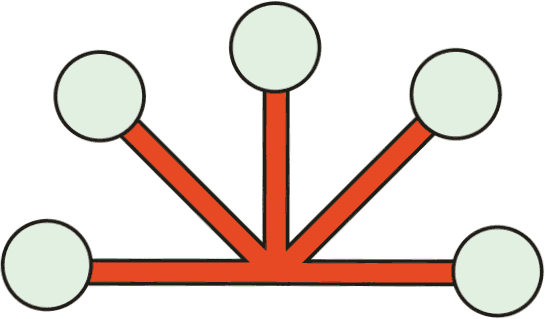The Planning Issue
Deciding what to work on and how you'll get there
Not sure where to start? This guide can help.
There are many things a company can get wrong and survive, but building the wrong stuff isn’t one of them. Every company has their own process for deciding what to build and how to coordinate across the organization to build it. Whether it comes naturally or is the result of a concerted effort and process, every company plans to achieve the same benefits:
- Focus on the right global priorities
- Ownership is clear
- Coordination across shared workstreams
- High shipping velocity
- Work is appropriately visible across the organization
- Shared enthusiasm about the direction of the company
If your company is small enough, or cohesive enough, for all these things to be true already, keep doing what you’re doing. Maybe all you need is gut instinct and inertia for your organization to build the stuff your customers love. But, when things start to get fuzzy on what to build, how to build it, and who is doing what to get there (and they often start getting fuzzy all at the same time), it may be time to start formalizing a process for how to put a plan together.
The goal is to get to a unified and realistic plan for what the company is collectively working towards over a given time horizon. This issue covers a structure, approach, and tactics for getting there.
There is an operational burden that comes along with planning. If that burden is not outweighed by how much it accelerates your organization’s output, it isn’t the right process, the right set of tactics, or the right time to implement them. Leaders, be judicious about how much process your planning process will entail. The more naturally-aligned teams are, the more compressed these phases can be.
Other issues
Not sure where to start? Select one or more tags below to filter the content of this zine:
Looking for:
- Nuts and Bolts
- Wrenches and Hammers
- Factory Favorites
- Recipe Under Development
Kool-Aid Serving Size:
- Kool-Aid Gulp
- Kool-Aid Sip
My role:
- Company Leader
- Crossfunctional Influencer
- Domain Expert / Team Lead
- Operator
Get more details on zine filters here
Filter descriptions
Looking for:
-
Nuts and Bolts
Foundational mechanisms to get started with. Most great organizations rely on their own version of this.
-
Wrenches and Hammers
Supplemental mechanisms to do more with. Many great organizations use these to close gaps or respond to challenges.
-
Factory Favorites
Lesser-utilized tactics that more companies could benefit from trying.
-
Recipe Under Development
Research on best practices and potential impact is still underway.
Kool-Aid Serving Size:
-
Kool-Aid Gulp
The highest-impact, furthest-reaching tactics for everyone to engage with.
-
Kool-Aid Sip
Nice-to-have or opt-in tactics for smaller groups to experiment with.
My role:
-
Company Leader
Someone with direct influence over the direction of the company and what is brought onto the company stage.
-
Crossfunctional Influencer
Someone who makes decisions across multiple teams or functional groups.
-
Domain Expert/Team Lead
Someone with strong command of a specific topic and/or the leader of a functional group.
-
Operator
Anyone getting work done with a command of the company’s values/standards and the inclination uphold them.
PHASE 1: VISION
By the end of the vision phase, you should have: articulated the longterm view of where you want to go
Longterm Vision Statement
Where the company is going
- If you want to keep innovating, the near-term plan must emerge from a longer-term one.
- Temporarily suspend your understanding of the constraints on your vision. The rest of the planning process will take care of bridging vision and reality.
- Take a look inward. What does your heart, gut, and soul say you should be working on?
- Take a look outward. Where do other company leaders, trusted team members, top users, trusted users, trusted partners, industry visionaries, and investors think we should be going?
- Check out the Vision Statement in The Constitutional Documents Issue for more tips
HOT TIPS
- From Facebook’s Little Red Book “With each step forward (in this industry), the landscape you’re walking on changes. So, we have a pretty good idea of where we want to be in six months, and where we want to be in 30 years. And every six months, we take another look at where we want to be in 30 years to plan out the next 6 months. It’s a little bit shortsighted and a little bit not. But any other approach guarantees everything you release is already obsolete.”
COMPANY STORY
PHASE 2: REALITY
By the end of the reality phase, you should have: a clear-eyed take on where things stand today
Company State Readout
The information required to generate a good plan
- Create a document that captures all of this information and publish it to the company
- Consider holding a forum to walk everyone through it. It’s a great chance to invite your team to not only engage with the broader context of their work but also share their interpretations of how things are going.
HOT TIPS
TEMPLATE
Keeping the Lights On
A unified view of what is required to keep the company and product running
- Only the resources left over can be allocated to net-new work.
- Gut check whether you are satisfied with the ratio of keep-the-lights-on to net-new work. (The expectations will probably differ across teams). Either way, You may discover that you want to find ways to become more efficient and unlock some of your resources for net-new work.
HOT TIPS
Roadmap
A unified view of what the team is working towards shipping
- The most important thing to represent is what is shipping and when.
- Take the perspective of what the user sees.
- Compare this against your vision statement. Is your roadmap getting you where you want to go? Is there a better way? Is there anything that should be added? Re-ordered?
- This is a good time to decide whether you want to take any big swings or kick off any experiments. Get granular about what would be required to get that work done (owners, resources, etc.).
- As the coordination complexity increases, it becomes increasingly important to represent owners and crossfunctional dependencies.
HOT TIPS
Roadmap Feedback
Engaging more perspectives in what the team is working towards shipping soon
- Treat feedback as an input, not a directive.
- Engaging employees in sharing inputs and feedback on what work ends up represented and prioritized will help bring them along in the planning process.
- Whether or not you decide to move in the direction of the feedback you receive, you’ll have good fodder for communicating the direction to your team and your users.
HOT TIPS
- At Figma, sub-teams were invited to hour-long roadmapping sessions. For the first 15 minutes, PMs shared high-level overviews of their plans (goals, key projects, target metrics, timelines). As the PMs presented, team members voted on which topics they wanted to discuss for the next 45 minutes. That discussion often influenced some light re-prioritization as needed.
COMPANY STORY
TEMPLATE
Resourcing View
The resources required to get it all done
- Once you know what’s required to keep the lights on and to build what you want to build going forward, it’s time to represent what resources are required to get there. This is a critical step towards creating plans that are realistic.
- Identify any gaps between where you want to go and what resources you have to get there. Gaps can also include knowledge, experience, or expertise on your existing team.
- This will ultimately be the focal-point for the decision-making process about what you’ll prioritize.
HOT TIPS
PHASE 3: DECISIONS
By the end of the reality phase, you should have: made the difficult tradeoffs required to bridge the vision for your company and reality of the work over a discrete time period
Prioritization and Resourcing Decisions
Making the hard trade-offs
- This should be a centralized process run by company leaders.
- It’s going to hurt! If it doesn’t, you’re probably not actually prioritizing. The more ties you break now, the easier it will be for everyone to sprint later.
- Prioritizing is all about the allocation of limited resources. Start the process with a maximum budget (headcount, funds) you are willing to allocate through this process. You don’t have to hit it, but it should be a clearly-defined number (no matter how much cash you have in the back and how much pressure you are getting to grow).
- Bias for getting work to completion over getting work in progress.
- Always be willing to add resources to things that are working.
- Be extremely judicious about (and perhaps require a lot of convincing to) allocate resources to things that are not working, things that are not started, or things that are not yet proven (ie- just started)
- Try to avoid big swings in resourcing over a single planning period. Anything >10% change in allocation should raise the eyebrows at minimum and be unequivocally avoided at maximum.
- Be as consistent and principled as possible in decision-making, always explain why a decision is made.
- Planning is a good time for headcount requests because centralized oversight helps ensure a globally-optimized org structure. Still, you may want to set-up additional processes for securing headcount outside of the planning process.
- Once you’re ready to allocate resourcing and budgets, make a quick pie chart of the total net-new resources allocated by organization/team. Does this look directionally right to you based on the global priorities you set?
- Don’t forget, resources can also come in the form of short-term staffing from other teams, money, and contractors.
HOT TIPS
- Quote from Ben Horowitz’s 2014 post on how the instinct to run a bottoms-up resourcing process “should only be followed if you wish to bloat your company to the brink of bankruptcy and create a culture of chaos…When I asked my managers what they needed, I unknowingly gamified the budgeting process. The game worked as follows: The objective was for each manager to build the largest organization possible and thereby expand the importance of his function. Through the transitive property of status, he could increase his own importance as well. Now you may be thinking, “That wouldn’t happen in my company. Most of my staff would never play that game.” Well, that’s the beauty of the game. It only takes one player to opt in, because once someone starts playing, everybody is going in — and they are going in hard.”
RESOURCE
Decision Log
Documentation for stakeholders on key decisions made and why
- In this context, a decision is something that renders a current belief of expectation invalid and should be logged.
- If a decision is contentious, and many of these will be, explain why you made the decision.
- To the extent possible, organize this log by principles. This will help everyone understand and internalize the principles behind prioritization.
- Articulating what you’re not focused on can be as important as articulating what you are focused on, especially when it clears up any incorrect assumptions or presents a meaningful shift in strategy.
HOT TIPS
PHASE 4: THE PLAN
By the end of the reality phase, you should have: created an artifact that articulates what you plan to ship over a discrete time period and how you’ll get there
The Plan
The artifact of what the company is planning to deliver over a discrete time period
- Publish these to a central hub anyone can visit at any time.
- The company-wide plan is an important visibility mechanism for the company. Anyone who reads the plan should come away with a solid understanding of what your company is working on and why. Pick the format that will do the best job at that for the average employee in the corner of your organization reading the plan.
- Plans should ultimately be oriented towards net-new things, but should at least nod to the work teams are doing to keep the lights on.
- Articulating what you’re not doing can be as important as articulating what you are doing.
- Remember, the headcount allocated today will not be producing work for >= 6 months (between hiring and onboarding)
- Plan approval also means alignment on plans and on how their success will be evaluated.
HOT TIPS
- Intel/Google: One popular format for plans is an OKR (stands for objectives and key result). They are often set at the company level with team and individual OKRs laddering up into the company OKRs. OKR’s were conceived by Andy Grove at Intel and have since been adopted and popularized by Google. In the foreword of John Doerr’s book Measure What Matters, Larry Page (Google cofounder) says “OKRs have helped lead us to 10× growth, many times over. They’ve helped make our crazily bold mission of ‘organizing the world’s information’ perhaps even achievable. They’ve kept me and the rest of the company on time and on track when it mattered the most.
- Amazon: Amazon formats their plans as 6-page memos called OP’s for (Operating Plan’s) that are all reviewed by the executive team. They are meant to be forward-looking in where the team plans to go, while also rigorously evaluating past performance. They can be thought of as business plans or investment proposals. The executive’s evaluation of the OP can result in a range of actions from the team’s full staffing to its disbanding.
COMPANY STORY
Company plans can take many, many different formats. Here are a few to explore:
- A simple list of ships
- OKR’s: objectives and key results
- OSR’s: objective stack-rank
- (An Amazon Favorite) Mock Press Release: If someone were to write an article about the great work your team did this quarter, what would it say (in prose)?
TEMPLATE
PHASE 5: ACCOUNTABILITY AND EXECUTION PREPAREDNESS
Plans are only as useful as your ability to execute on them. So many organizations go through great lengths to generate great plans, and then forget to check in on them.
As soon as your planning process ends, the real work begins. Make sure to quickly and thoroughly:
- Help teams get the resources that were allocated to them. That might be new headcount, crossfunctional resources, budgets, or access tooling.
- Set up accountability mechanisms. See The Shipping Great Work Issue for how to do this.




















